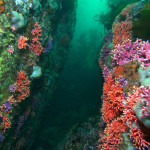By guest writers Allison Randolph and Elizabeth Weinberg, NOAA Office of National Marine Sanctuaries.Â
For more than 40 years, national marine sanctuaries have worked to protect special places in America’s oceans and Great Lakes waters, from the Hawaiian Islands to the Florida Keys, from Lake Huron to American Samoa. Backed by one of the nation’s strongest pieces of ocean-conservation legislation, the National Marine Sanctuaries Act, the sanctuaries seek to preserve the extraordinary beauty, biodiversity, historical connections and economic productivity of our most precious underwater treasures. And — lucky for you — most of these places are accessible to recreational divers. Sanctuary waters are filled with unique ecosystems, harboring a spectacular array of plants, animals and historical artifacts, all waiting to be explored. National marine sanctuaries belong to everyone, so dive in.
Monterey Bay National Marine Sanctuary
Slip beneath the ocean’s surface along California’s central coast and you’ll be amazed by a diversity of habitats and the abundance of marine life. Explore a giant kelp forest; investigate the crevices of a rocky reef; and discover all that lives in the open ocean.
Stretching down 276 miles of the California coast, Monterey Bay National Marine Sanctuary encompasses more than 6,000 square miles of ocean. Its diverse marine ecosystems support more than 525 species of fish, 180 species of seabirds, 34 species of marine mammals, four species of turtle, and an incredible abundance of invertebrates and algae. The sanctuary also contains one of the largest and closest-to-shore deep, underwater canyons in North America. Offshore canyons bring cold, nutrient-rich water in close to shore, supporting a wealth of ecosystems — and occasionally affording glimpses of strange deep-sea creatures that venture towards the surface.
Home to some of central California’s most popular dive sites, Monterey Bay National Marine Sanctuary includes 13 different zone types, each with associated regulations restricting or promoting specific activities. So whether you’re planning to dive the breakwater in Monterey, Lovers Point in Pacific Grove, or the Pinnacles at Carmel Bay, it’s important to check the regulations at each specific site.
While diving, you can help protect this marine sanctuary by practicing good ocean etiquette. First and foremost, don’t remove anything from the underwater environment since all things — living and nonliving — play an important role in the health of the ecosystem. Additionally, make sure to keep a safe distance from animals you encounter as well as the surrounding habitat; streamlining your dive equipment can improve your ability to do so. With so many people coming to enjoy the sanctuary’s underwater beauty each year, every careful diver can make a big impact.
Experience the wonders of Monterey Bay National Marine Sanctuary and other national marine sanctuaries via more photos here.
Cover image credit: Pete Naylor/REEF
The post Exploring Monterey Bay National Marine Sanctuary appeared first on Scuba Diver Life.









